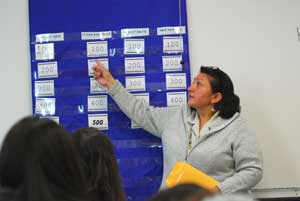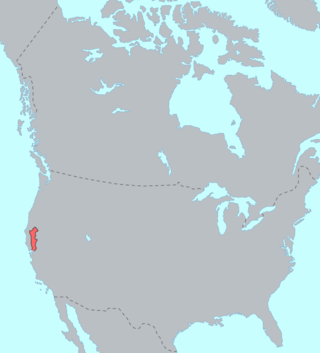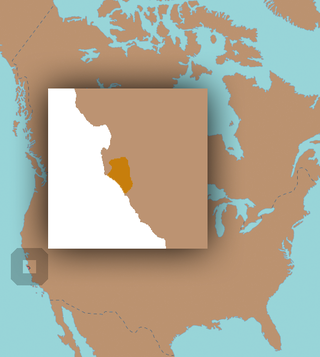
In phonology, an allophone is one of multiple possible spoken sounds – or phones – used to pronounce a single phoneme in a particular language. For example, in English, the voiceless plosive and the aspirated form are allophones for the phoneme, while these two are considered to be different phonemes in some languages such as Central Thai. Similarly, in Spanish, and are allophones for the phoneme, while these two are considered to be different phonemes in English.

Achomawi are the northerly nine bands of the Pit River tribe of Palaihnihan Native Americans who live in what is now northeastern California in the United States. These 5 autonomous bands of the Pit River Indians historically spoke slightly different dialects of one common language, and the other two bands spoke dialects of a related language, called Atsugewi. The name "Achomawi" means river people and properly applies to the band which historically inhabited the Fall River Valley and the Pit River from the south end of Big Valley Mountains, westerly to Pit River Falls. The nine bands of Achumawi lived on both sides of the Pit River from its origin at Goose Lake to Montgomery Creek, and the two bands of Atsugewi lived south of the Pit River on creeks tributary to it in the Hat Creek valley and Dixie Valley.
The Atsugewi are Native Americans residing in northeastern California, United States. Their traditional lands are near Mount Shasta, specifically the Pit River drainage on Burney, Hat, and Dixie Valley or Horse Creeks. They are closely related to the Achomawi and consisted of two groups. The Atsugé traditionally are from the Hat Creek area, and the Apwaruge are from the Dixie Valley. They lived to the south of the Achomawi.

The Hokan language family is a hypothetical grouping of a dozen small language families spoken mainly in California, Arizona, and Baja California.
The Achumawi language is the indigenous language spoken by the Pit River people in the northeast corner of present-day California. The term Achumawi is an anglicization of the name of the Fall River band, ajúmmááwí, from ajúmmá "river". Originally there were nine bands, with dialect differences primarily between upriver and downriver, demarcated by the Big Valley mountains east of the Fall River valley.

Yurok is an Algic language. It is the traditional language of the Yurok people of Del Norte County and Humboldt County on the far north coast of California, most of whom now speak English. The last known native speaker died in 2013. As of 2012, Yurok language classes were taught to high school students, and other revitalization efforts were expected to increase the population of speakers.

Yokuts, formerly known as Mariposa, is an endangered language family spoken in the interior of Northern and Central California in and around the San Joaquin Valley by the Yokuts people. The speakers of Yokuts languages were severely affected by disease, missionaries, and the Gold Rush. While descendants of Yokuts speakers currently number in the thousands, all languages apart from Valley Yokuts are now extinct.
Palaihnihan is a language family of northeastern California. It consists of two closely related languages, both now extinct:

Chumashan was a family of languages that were spoken on the southern California coast by Native American Chumash people, from the Coastal plains and valleys of San Luis Obispo to Malibu, neighboring inland and Transverse Ranges valleys and canyons east to bordering the San Joaquin Valley, to three adjacent Channel Islands: San Miguel, Santa Rosa, and Santa Cruz.
Americanist phonetic notation, also known as the North American Phonetic Alphabet (NAPA), the Americanist Phonetic Alphabet or the American Phonetic Alphabet (APA), is a system of phonetic notation originally developed by European and American anthropologists and language scientists for the phonetic and phonemic transcription of indigenous languages of the Americas and for languages of Europe. It is still commonly used by linguists working on, among others, Slavic, Uralic, Semitic languages and for the languages of the Caucasus, of India, and of much of Africa; however, Uralists commonly use a variant known as the Uralic Phonetic Alphabet.
The Shasta language is an extinct Shastan language formerly spoken from northern California into southwestern Oregon. It was spoken in a number of dialects, possibly including Okwanuchu. By 1980, only two first language speakers, both elderly, were alive. Today, all ethnic Shasta people speak English as their first language. According to Golla, there were four distinct dialects of Shasta:

Wintuan is a family of languages spoken in the Sacramento Valley of central Northern California.

Esselen was the language of the Esselen Nation, which aboriginally occupied the mountainous Central Coast of California, immediately south of Monterey. It was probably a language isolate, though has been included as a part of the hypothetical Hokan proposal.
Wintu is a Wintu language which was spoken by the Wintu people of Northern California. It was the northernmost member of the Wintun family of languages. The Wintun family of languages was spoken in the Shasta County, Trinity County, Sacramento River Valley and in adjacent areas up to the Carquinez Strait of San Francisco Bay. Wintun is a branch of the hypothetical Penutian language phylum or stock of languages of western North America, more closely related to four other families of Penutian languages spoken in California: Maiduan, Miwokan, Yokuts, and Costanoan.
Achomawi traditional narratives include myths, legends, tales, and oral histories preserved by the Achomawi people of the Pit River basin of Northeastern California.
Shasta traditional narratives include myths, legends, tales, and oral histories preserved by the Shasta people of northern California and southern Oregon.
This article is about the sound system of the Navajo language. The phonology of Navajo is intimately connected to its morphology. For example, the entire range of contrastive consonants is found only at the beginning of word stems. In stem-final position and in prefixes, the number of contrasts is drastically reduced. Similarly, vowel contrasts found outside of the stem are significantly neutralized. For details about the morphology of Navajo, see Navajo grammar.
The Pit River Tribe is a federally recognized tribe of eleven bands of indigenous peoples of California. They primarily live along the Pit River in the northeast corner of California. Their name also is spelled as "Pitt River" in some historical records.
Victor Golla (1939–2021) was a linguist and a leading expert on the indigenous languages of California and Oregon, especially the Pacific Coast Athabaskan subgroup of the Athabaskan language family and the languages of the region that belong to the Penutian phylum. He was emeritus professor of anthropology at Humboldt State University and lived in Trinidad, California.
Proto-Algic is the proto-language from which the Algic languages are descended. It is estimated to have been spoken about 7,000 years ago somewhere in the American Northwest, possibly around the Columbia Plateau. It is an example of a second-level proto-language which is widely agreed to have existed. Its main researcher was Paul Proulx.








